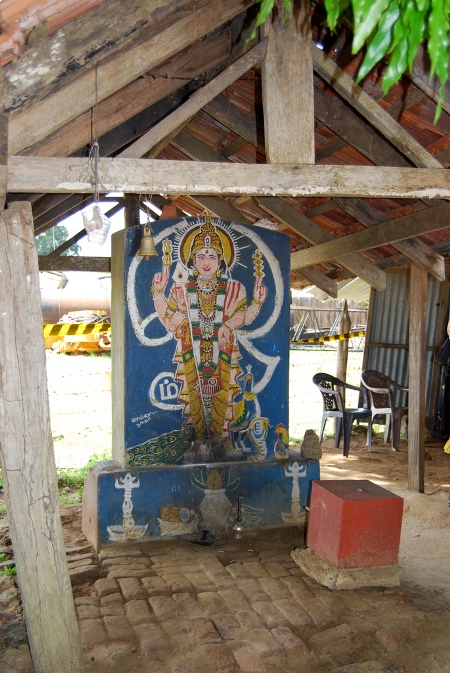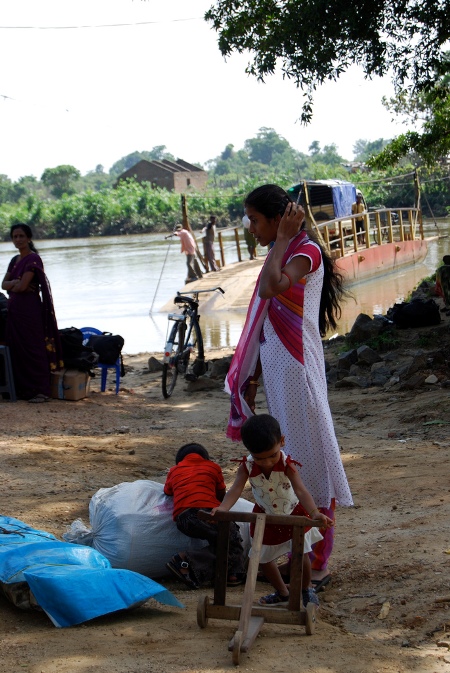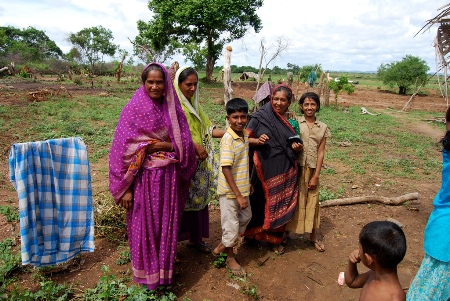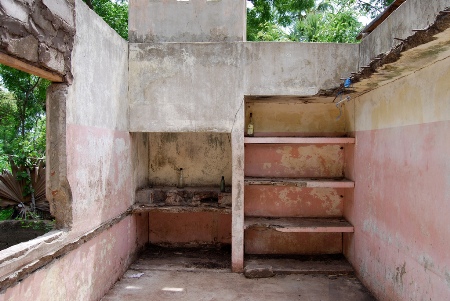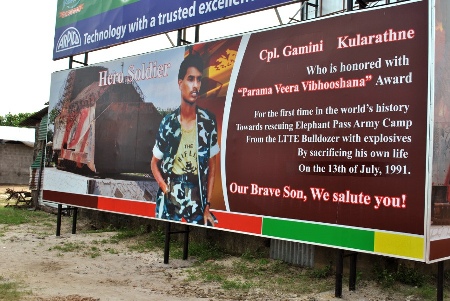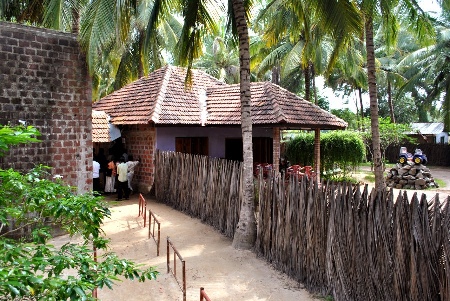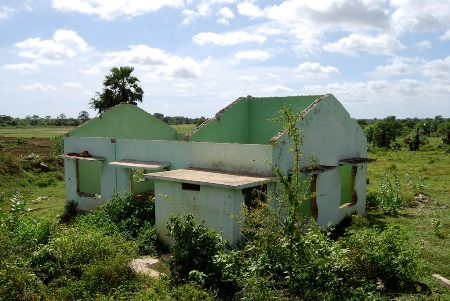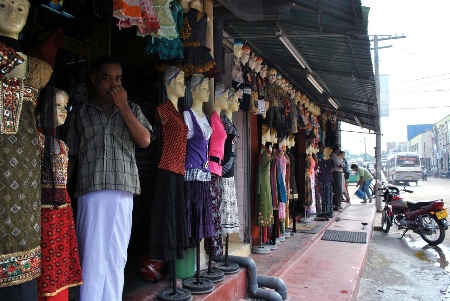Ilankai Tamil Sangam28th Year on the Web Association of Tamils of Sri Lanka in the USA |
|||
 Home Home Archives Archives |
Sri Lankan Tamil NationalismPast, Present and Futureby DBS Jeyaraj, dbsjeyaraj.com, January 14, 2011
“Thai Piranthaal Vazhi Pirakkum” is a popular saying in Tamil about the month of January or “Thai” in Tamil. It’s meaning in English would be something like this – “When January is born, a way will dawn”. The birth of January in the Hindu Almanack is in mid-January according to the Western calendar. It generally co-incides with the Tamil harvest festival called “Pongal” or “Thaippongal”.It is usually a season of Thanksgiving and celebration. Amidst the atmosphere of festive joy, it is also a time of individual and group reflection where the past is re-examined critically, present re-assessed pragmatically and future plans renewed optimistically.
Murugan Temple in Verugal ~ pic by: Drs. Sarajevo
Returnees in Verugal ~ pic by: Drs. Sarajevo It is in that context therefore that this column delves into the phenomenon of Sri Lankan Tamil nationalism that has been the driving force behind Tamil politics for several decades. The objective is to briefly re-appraise the past with the wisdom of hindsight, analyse the present and present a prognosis of a potential future. PREDICAMENT This evaluation at this point of time is made necessary by the prevailing predicament of the Sri Lankan Tamils. It may not be an exaggeration to state that the Tamils of Sri Lanka are undergoing what is perhaps the worst phase in their post-Independence history. The inability or unwillingness of Sinhala and Tamil politicians to resolve their differences and evolve an equitable model of power sharing resulted in much ethnic friction. This friction escalated into war. Initially it was a low –intensive guerrilla insurgency. Subsequently it developed into positional warfare .Ultimately it was a full-fledged war of a very brutal nature.
Muslims returnees in Mageed Nagar, Trincomalee District – picture by Drs. Sarajevo The effects of this long war were felt in all parts of the country and affected all of its people. Violence spread to areas outside the North and East too with the anti-Tamil pogrom of July 1983 remaining etched in memory as one where Tamil civilians were butchered in large numbers. Other acts of violence committed by Tamil militants caused much death and harm in Colombo and other places to Sinhala, Muslim and Tamil civilians.
In-built cupboards in a house that was deserted 25 years ago in Thennamaravadi, Trincomalee district ~ pic by Drs. Sarajevo While there is no denying that the war impacted on all the people of Sri Lanka it must be admitted that the Tamil people of the North and East bore the brunt of suffering . Also the Tamil inhabited regions of the North and East became in practice the theatre of militant conflict. The protracted nature of the conflict saw the north and east virtually turning into a “scorched earth”. The hopelessly beleaguered Tamils have paid a heavy price for waging this uneven war. CONSEQUENCES The war may have ended but the consequences of prolonged conflict will continue to be felt for a very long time. Decades of escalating war culminating in the military debacle of Mullivaaikkaal have resulted in the deaths of thousands of people – civilians, guerillas and security forces. The majority of civilian casualties are from the Tamil ethnicity.
Sign along A9 ~ pic by Manori R Apart from the loss of life there has also been a large loss of limb. Thousands of people have been physically affected in various ways like aerial bombardment, artillery shelling, landmines, explosions, crossfire etc. A large number of those affected are physically impaired or disabled. There has also been destruction of property and economic regression. Hundreds of thousands of dwellings have been destroyed or heavily damaged. Agriculture, fisheries, small industry etc have been severely curtailed. Educational, health ,transport facilities have eroded. Infra-structure has been demolished. Economic life has de-generated. Social and cultural activity has diminished. Large –scale social and cultural events have decreased considerably. There has been limited scope for meaningful aesthetic and creative pursuits. More importantly there has been a brutalisation of society and hardening of values. Much of the violence and criminal activity going on now are symptomatic of a post-war society. In that context one issue overlooked or ignored is the psychological trauma and stress undergone by the people during these years of war. There has been very little psychological counselling. The First World War was for four years. The Second World War was for six years. But this intensive war has gone on for decades and decades. Moreover it was confined to a limited space. The people have paid a huge price. POPULATION Numerically the Sri Lankan Tamils are a depleted, decaying entity. Death, destruction and displacement have wrought havoc. The ravages of war leading to large-scale migration has resulted in more than a million Tamils relocating to various parts of the world. Other reasons such as late marriage due to Dowry problems and a comparatively lower birth rate among more educated Tamils have also contributed to this population drop. The nationwide official census is scheduled for 2011. When it was compiled 20 years ago in 1981 the Tamils were 11.6 % of the population. Presently it is estimated that the percentage would drop to around 8%. There is a strong possibility that the Muslim population would exceed the Tamil count by a few decimal points. If that happens the Sri Lankan Tamils by themselves would no longer be the second largest community on the Island. The Tamils can claim to be the second largest entity only by combining their numbers with that of the Up Country Tamils or Tamils of recent Indian origin. But the Up Country Tamils would not like to be identified along with the Sri Lankan Tamils as they fear that they would be submerged in such a union. DEMOGRAPHY Apart from this decline in numbers there has been a qualitative and quantitative change in demography too. The horrors of war and the destruction unleashed in the Northern and Eastern Provinces have resulted in massive displacement. Hundreds of thousands of Tamils have moved out of these provinces and found new homes in other parts of the Country particularly Colombo and urban areas of the Western Province. As a result the ethnic ratio of the North – Eastern provinces has changed to a great extent. It is surmised now that more Sri Lankan Tamils live in the seven Sinhala majority provinces than in the North and East regarded as their areas of “historic habitation”. The 2011 Census may very well confirm this truth with exact figures. On the other hand there has been much displacement and relocation within the Northern and Eastern provinces too. Many people have moved out of Internally displaced camps but are yet to return to their original homes. They live with relatives and friends or eke out a miserable living as squatters. There has also been a trend of families moving out of villages to semi –urban and urban areas. This in turn has transformed the demographics of these places. There are very few “original” inhabitants in some places and in many areas “new” communities of residents have evolved. MILITARISATION A profound result of the war has been the militarisation of the North and East. Before the war began, there were only a few army, navy and airforce installations in the North and East. Security personnel were essentially confined to barracks. Today the situation is different. There is a pervasive security force presence in almost all areas of the North and East. Although there are officials from the civil administration and elected political representatives the “de-facto” administrators are the security force officers in each area or region. Unlike the other seven provinces the governors of the Northern and Eastern provinces wield effective executive power in practice. They are both retired Army and Navy officers. The bitter reality is that there is little chance of this overwhelming military presence decreasing in the near future. Actually there is very likely to be a permanent military presence in certain strategic areas. Military cantonments and townships are in the pipeline. After decades of fighting a separatist war no government can be expected to withdraw or reduce the military presence in a very short time particularly when “vocal warriors” continue to beat war drums in the Tamil Diaspora. SADNESS In short, what we witness today is the sad spectacle of a proud people being reduced to deterioration, deprivation and resultant despair in their own land. There is a distinct disconnect between the travails and troubles of the Tamils living in areas comprising the “arena of war” and the chest –thumping rants and raves of sections of the Tamil Diaspora and Tamil Nadu polity. There is a deep sense of personal sorrow as I write this article reflecting on the past and pondering about the future. It is a sadness that will not go away in a hurry. It is a sadness compounded by the fact that I foresaw this evolving tragedy and cried out for a course correction to the Liberation Tigers of Tamil Eelam(LTTE) publicly and privately. Not only was I one of the few Tamil voices in the wilderness but was also attacked viciously by LTTE minions as a traitor and lackey and sell-out etc for daring to speak truth to power. Today what I feared greatly has come to pass. What is unbearable about this tragedy is that it need not have happened. Unlike the Tsunami this could have been avoided but the mad dictates of militarism coupled with an irrational, unrealistic reading of the political, military and diplomatic situation has plunged the Tamils into a deep, deep morass. TRAGEDY Mere statistics or journalistic descriptions cannot convey the abject ,forlorn situation facing hundreds of thousands of Tamils who suffered in this war. The families of disappeared, the families of detenues, the widows, the orphans, the single parent families, the broken households, the limbless, the bed –ridden, the poverty ,the ruins and the graves form together this colossal tragedy. How will this war-affected, impoverished people rise up from the dust-heap pr resurrect themselves from the ashes? What is saddening now is the blatant failure of certain elements of Tamil society to comprehend or realise the serious nature of the Tamil predicament today. Like the Bourbons of France these segments seem to have learnt or forgotten nothing.
Honour to a Sri Lanka Army soldier ~ pic by Manori R While the silent majority of Tamils remain passive these “active” sections are once again hogging the megaphone vociferously. Their boasts and demands would make angels weep! Their discourse is provocatively confrontational. As a western diplomat observed to this writer “These guys dont seem to realise that the LTTE lost the war and as a result all Tamils are in a difficult situation”.
House used by LTTE leader in Viswamadu ~ pic by. Manori R The need of the hour is for Tamils to evolve a sensible and pragmatic approach to the situation they are in. What is necessary now is not confrontation but cooperation. Those continuing the old politics of sabre-rattling must realise there is no sword or blade in the scabbard or sheath to “scare” the enemy. Instead these vocal warriors make laughing stocks of themselves without perhaps realising it. EMOTIVE This inability or unwillingness to recognize the tragic plight of the Tamil people and adopt a practical approach rather than continuing with an unrealistic confrontational mode is not something which evolved in a vacuum. There is a history behind this emotive content in Tamil politics. It has been prevalent ever since the Tamil polity began experiencing political anxiety over the perceived threat of Sinhala majoritarian hegemony. It is indeed a historical fact that an empowered Sinhala majority adopted certain measures that were detrimental to the welfare and interests of the Tamil and Muslim people in post-Independence Sri Lanka. While the Muslim political leaders pursued a non – confrontational approach to surmount or contain these challenges the Tamil political leaders engaged in the politics of resistance. Even Soumiyamoorthy Thondaman abandoned the politics of resistance after a period of time and instead embarked on a new course of cooperative politics which paid rich dividends for his victimised people. There are however certain reasons for the Sri Lankan Tamil political leadership to have engaged in resistance politics of a combative nature. A major contributory factor in this respect was the tendency on the part of major Sinhala dominated political parties like the United National Party(UNP) and Sri Lanka Freedom Party (SLFP) to underestimate the validity of Tamil grievances and disregard the necessity to address and redress them. There was also the insecurity in Sinhala consciousness despite being the numerical majority on the Island. Atavistic fears of past history reinforced this attitude. As a result mountains were made out of molehills and there was instilled an entrenched sense of hostility in the Sinhala political mainstream to any demand by the Tamils for power sharing through federalism or devolution. SEPARATION There was a fear of possible separation. Hence all requests for sharing power at the periphery were perceived as Trojan horses for covert secessionism. Ironically what was feared became a reality as a result of this failure to accommodate reasonable demands. A full – fledged Separatist movement conducted a savage armed struggle and succeeded for years in maintaining a de-facto state. Having failed in the attempts to win back the lost rights of the Tamil people the Tamil political leadership found itself at a loss in 1970 where a United Front Government with a steam roller majority was elected. The proposals put forward by the Federal Party (FP) to evolve a federal solution were rejected and a unitary structure was enshrined in the new republican Constitution as an entrenched clause. The Tamils were now in the depths of despair. But instead of capitulating under desperate circumstances the course of Tamil politics became more drastic and extreme. The earlier desire to accommodate legitimate Tamil aspirations within a united Sri Lanka through equitable power sharing gave way to a yearning for secessionism. The Tamils re-imagined themselves as a distinct nation and demanded a separate state comprising the Northern and Eastern provinces. The right of Self-determination was invoked as the basis for this demand. The major Tamil parties came together as the Tamil United Liberation Front(TULF) and contested the 977 elections on a platform of Separatism. The TULF won 18 of the 19 Tamil majority seats in the North-East and claimed to have obtained a mandate for Tamil Eelam. With the wisdom of hindsight it could be stated that it was highly unrealistic of the Tamil leadership to have thought separation was possible in a situation where the demands for simple power sharing through devolution had been rejected. The political leadership may have even resorted to this demand as a bargaining ploy expecting the Sinhala leadership to agree to a negotiated meaningful compromise. Alas! This was not to be. TRANSFORMED But the secessionist demand transformed Tamil politics. The introduction of media –wise standardisation acted as a catalyst to radicalise Tamil youths. Several Tamil youths began engaging in political violence of a limited nature. The introduction of harsh measures such as the Prevention of Terrorism Act (PTA) estranged the Tamil population further. And then came the anti-Tamil pogrom of July 1983. This was followed by the sixth amendment to the Constitution disallowing separatism. With the elected representatives of the Tamils forfeiting their seats by refusing to take the mandatory oath, Tamil Parliamentary representation for the Northern province ended at that time. India stepped into the ensuing vacuum and offered its good offices to mediate a negotiated settlement. At the same time New Delhi trained and armed Tamil militant groups in a bid to exert pressure on Colombo. Indian involvement was not purely altruistic and had its own strategic interests at heart. Indian policy reached its goal and former President JR Jayewardena signed the Indo-Lanka accord with Rajiv Gandhi. But the LTTE led by Velupillai Prabhakaran refused to lay down arms as expected and continued with the fighting and even took on the Indian army who entered Sri Lanka as peace-keepers. OPPORTUNITIES From then onwards it was prolonged war with interludes of peace. The LTTE had four great opportunities to play a political role in peace processes and bring about a negotiated settlement. They were the India inspired peace process, the talks with President Ranasinghe Premadasa, the talks with President Chandrika Kumaratunga and the Norway facilitated peace process with Ranil Wickremesinghe as Prime Minister. In a path breaking development both sides agreed to explore federalism as a solution in Oslo. Sadly the tigers did not stay the course. The LTTE through its enforced boycott ensured the success of President Mahinda Rajapaksa in 2005. Within a short time war escalated. Thereafter with massive International and Indian backing the Sri Lankan armed forces gained the upper hand. Gradually the LTTE was beaten back and finally cornered in a strip of littoral in the Karaithuraipatru AGA division in the Mullaitheevy district. The coup de grace was delivered in mid –May 2009 and the LTTE was militarily annihilated. The decimation of the tigers militarily has brought about an asymmetrical situation in the power equation. The Tamil people have been declining in almost every sphere since July 1983 but the LTTE had gradually set up a mighty military machine. As stated by this columnist in earlier articles the Tamils had descended horizontally as a people but the LTTE had ascended vertically as an armed force. Now with the LTTE gone the powerless Tamils in Sri Lanka are in dire straits. RAMIFICATIONS Had the LTTE transformed its military strength into political bargaining power at the appropriate time the Tamil people would certainly be in a better position. But this did not happen and today the Tamils as a people are in a precarious situation.
Community Centre in Santhanoveddai ~ pic by Drs. Sarajevo Hard as it may be for some Tamils to admit the Tamil people today are entirely at the mercy of the Sri Lankan state. Despite lip service paid by some to the contrary the reality today is that there is no effective support Internationally for the Tamil cause. There is a powerful Sinhala dominated government in Colombo and the disempowered Tamils have no means to influence it. The LTTE by its actions has caused irredeemable harm to the Tamil people. What is troubling in this situation is the inability and unwillingness of sections of the Tamil people to comprehend the ramifications of their predicament. The confrontational attitude of vocal warriors continues. Instead of trying to arrive at some form of political reconciliation and work for the upliftment of the shattered and battered people, an abrasive style of politics is still prevalent. The politics of confrontation is being followed in the name of “Thesiyam” or nationalism. NATIONALISM This in turn is souring the climate further. The Sinhala hawks with their project of turning Sri Lanka into a Sinhala supremacist state are strengthened. The moderate Sinhalese who want to live in peace and friendship with their Tamil counterparts are confused. The progressive Sinhalese who want to make Sri Lanka a plural nation and ensure equality to all her people are weakened.
In the Town of Jaffna ~ pic by: R. Manori It is against this backdrop that this column wishes to examine briefly the impact of Tamil nationalism in the past, its present role and its potential for the future. This would be done in forthcoming articles with the objective of realistically assessing the present plight of Sri Lankan Tamils and encourage the Tamil people to follow a pragmatic course of action that would enable the long suffering people to better their lot and regain their rightful position under the Sri Lankan sun. DBS Jeyaraj can be reached at djeyaraj2005@yahoo.com
| ||
